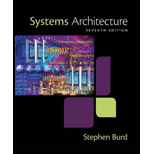
Systems Architecture
7th Edition
ISBN: 9781305080195
Author: Stephen D. Burd
Publisher: Cengage Learning
expand_more
expand_more
format_list_bulleted
Question
Chapter 2, Problem 8RQ
Program Plan Intro
Workstation:
- A workstation is a special computer that is designed for technical or scientific applications.
- Workstation refers to the group of hardware offered by companies such as Sun microsystems, Apollo, Silicon graphics and so on.
- Workstations are generally used for visualization and manipulation of different types of complex data such as three dimensional
mechanical design, animation, rendering of images and mathematical plots.
Desktop Computers:
- A desktop computer is a personal computer which is used for a variety of purposes such as graphic design, data entry, research and gaming.
- It is mainly designed for regular use at a single location or near a desk or a table because of its size and power requirements.
- A desktop computer has a monitor or another display, keyboard, mouse and horizontal or vertical form factor.
Expert Solution & Answer
Want to see the full answer?
Check out a sample textbook solution
Students have asked these similar questions
>
Comparable
Method
- methodName: String
-priority: int
+ Method()
+ Method(methodName: String, priority: int)
+ abstract specificWay(): void
+ Getters and setters for all fields
compareTo(otherMethod: Method): int
+ toString(): String
ReadMethod
- language: String
+ ReadMethod()
+ ReadMethod(methodName: String,
priority: int, language: String)
+ specificWay(): void
+ Getters and setters for language
+ toString(): String
Part 1.1. Implement the abstract class Method implements Comparable interface according to its UML
diagram. Add comments stating where data fields, constructors, toString(), and other methods are (if
any). Neither method should have an empty body unless abstract methods.
1. two constructors (default and the constructor with all fields)
2. getters and setters for all fields (methodName and priority).
3. toString() method: modify by yourself to match the example output.
4. Abstract method void specificWay().
5. Implement compara To(Method otherMethod) to compare…
Exercise 1 Function and Structure [30 pts]
Please debug the following program and answer the following questions. There is a cycle in a linked
list if some node in the list can be reached again by continuously following the next pointer.
#include
typedef struct node {
int value;
struct node *next;
} node;
int ll_has_cycle (node *first)
if (first
NULL) return 0;
node *head = first%;B
while (head->next != NULL) {
}
if (head
first) {
return 1; }
head =
head->next;B
return 0;
void test_11_has_cycle() {
int i;
node nodes [6] ;
for (i =
0; i < 6; i++) {
nodes [i] .next = NULL;
nodes [i].value
i;
nodes [0] .next
=
&nodes [1];
nodes [1] .next
=
&nodes [2];
nodes [2] .next
&nodes [3];
nodes [3] .next
nodes [4] .next
& nodes [4];
NULL;
nodes [5] .next
&nodes [0];
printf("1. Checking first list for cycles. \n Function 11_has_cycle says it
has %s cycle\n\n", 11_has_cycle (&nodes[0])?"a":"no");
printf("2. Checking length-zero list for cycles. \n Function 11_has_cycle
says it has %s cycle\n\n",…
Hello, please solve this trying to follow this criteria. (use Keil)
Abstract describing the requirements and goals of the assignment.
List file with no errors or warnings.
Brief description of your implementation design and code.
Debugging screen shots for different scenarios with your reference and comments.
Conclusion
Chapter 2 Solutions
Systems Architecture
Ch. 2 - Prob. 1VECh. 2 - A(n) __________ is a storage location implemented...Ch. 2 - Prob. 3VECh. 2 - A problem-solving procedure that requires...Ch. 2 - Prob. 5VECh. 2 - Prob. 6VECh. 2 - Prob. 7VECh. 2 - Prob. 8VECh. 2 - The major components of a CPU are the __________,...Ch. 2 - A set of instructions thats executed to solve a...
Ch. 2 - Prob. 11VECh. 2 - Prob. 12VECh. 2 - Prob. 13VECh. 2 - A CPU is a(n) __________ processor capable of...Ch. 2 - Prob. 15VECh. 2 - The CPU __________ program instructions one at a...Ch. 2 - Most programs are written in a(n) __________, such...Ch. 2 - Prob. 18VECh. 2 - Prob. 19VECh. 2 - Prob. 20VECh. 2 - Prob. 21VECh. 2 - Prob. 22VECh. 2 - Prob. 23VECh. 2 - Prob. 1RQCh. 2 - What shortcomings of mechanical computation did...Ch. 2 - Prob. 3RQCh. 2 - What is a CPU? What are its primary components?
Ch. 2 - What are registers? What are their functions?
Ch. 2 - Prob. 6RQCh. 2 - Prob. 7RQCh. 2 - Prob. 8RQCh. 2 - How does a supercomputer differ from a mainframe...Ch. 2 - Prob. 10RQCh. 2 - Prob. 11RQCh. 2 - Prob. 12RQCh. 2 - How can a computer system be tuned to a particular...Ch. 2 - What characteristics differentiate application...Ch. 2 - In what ways do system software make developing...Ch. 2 - Why has the development of system software...Ch. 2 - Prob. 17RQCh. 2 - Tables 2.2 and 2.3 will probably be out of date by...
Knowledge Booster
Similar questions
- Write the following in C# WinForms. Implement a function in the main menu that makes the poacher move to random direction. The movement should seem seamless. The poacher can be drew by the following in the main menu. e.Graphics.DrawImage(poacherImage, poacher.X, poacherY, tileSize, tileSize); Create the appropriate poacher class as wellarrow_forwardWrite the following in C# WinForms. Implement a function in the main menu that makes the poacher move to random direction. The movement should seem seamless. The poacher can be drew by the following in the main menu. e.Graphics.DrawImage(poacherImage, poacher.X, poacherY, tileSize, tileSize);arrow_forwardWrite the following in C# WinForms. Implement a function in the main menu that makes the poacher move to random directions. The movement should seem seamless. The poacher can be drew by the following in the main menu. e.Graphics.DrawImage(poacherImage, poacher.X, poacherY, tileSize, tileSize);arrow_forward
- Write the following in C# WinForms. Create a poacher class that has random x and y values when created, private set function for x and y values. Implement a function in the main menu that makes the poacher move into random direction. The movement should seem seamless. The poacher can be drew by the following in the main menu. e.Graphics.DrawImage(poacherImage, poacher.X, poacherY, tileSize, tileSize); Write the following in C# WinForms. Create a poacher class that has random x and y values when created, private set function for x and y values. Implement a function in the main menu that makes the poacher move into random direction. The movement should seem seamless. The poacher can be drew by the following in the main menu. e.Graphics.DrawImage(poacherImage, poacher.X, poacherY, tileSize, tileSize);arrow_forwardWrite the following in C# WinForms. Create a poacher class that has random x and y values when created, private set function for x and y values. Implement a function in the main menu that makes the poacher move into random direction. The movement should seem seamless. The poacher can be drew by the following in the main menu. e.Graphics.DrawImage(poacherImage, poacher.X, poacherY, tileSize, tileSize);arrow_forwardWrite the following in C# WinForms. Create a poacher class that has random x and y values when created, private set function for x and y values. Implement a function in the main menu that makes the poacher move into random direction. The movement should seem seamless. The picture of the poacher is drew by e.Graphics.DrawImage(poacherImage, poacher.X, poacher.Y, tileSize, tileSize);arrow_forward
- Create a poacher class that has random x and y values when created, private set function for x and y values, and implement a function in the main menu that makes the poacher move into random direction. The movement should seem seamless. Write it in C# WinFormsarrow_forwardHi, please solve this trying to follow this criteria. (use Keil) Abstract describing the requirements and goals of the assignment. List file with no errors or warnings. Brief description of your implementation design and code. Debugging screen shots for different scenarios with your reference and comments. Conclusionarrow_forwardCan you solve using iterative expansionarrow_forward
arrow_back_ios
SEE MORE QUESTIONS
arrow_forward_ios
Recommended textbooks for you
 Systems ArchitectureComputer ScienceISBN:9781305080195Author:Stephen D. BurdPublisher:Cengage Learning
Systems ArchitectureComputer ScienceISBN:9781305080195Author:Stephen D. BurdPublisher:Cengage Learning A+ Guide to Hardware (Standalone Book) (MindTap C...Computer ScienceISBN:9781305266452Author:Jean AndrewsPublisher:Cengage Learning
A+ Guide to Hardware (Standalone Book) (MindTap C...Computer ScienceISBN:9781305266452Author:Jean AndrewsPublisher:Cengage Learning A+ Guide To It Technical SupportComputer ScienceISBN:9780357108291Author:ANDREWS, Jean.Publisher:Cengage,
A+ Guide To It Technical SupportComputer ScienceISBN:9780357108291Author:ANDREWS, Jean.Publisher:Cengage, Enhanced Discovering Computers 2017 (Shelly Cashm...Computer ScienceISBN:9781305657458Author:Misty E. Vermaat, Susan L. Sebok, Steven M. Freund, Mark Frydenberg, Jennifer T. CampbellPublisher:Cengage Learning
Enhanced Discovering Computers 2017 (Shelly Cashm...Computer ScienceISBN:9781305657458Author:Misty E. Vermaat, Susan L. Sebok, Steven M. Freund, Mark Frydenberg, Jennifer T. CampbellPublisher:Cengage Learning Principles of Information Systems (MindTap Course...Computer ScienceISBN:9781305971776Author:Ralph Stair, George ReynoldsPublisher:Cengage Learning
Principles of Information Systems (MindTap Course...Computer ScienceISBN:9781305971776Author:Ralph Stair, George ReynoldsPublisher:Cengage Learning Principles of Information Systems (MindTap Course...Computer ScienceISBN:9781285867168Author:Ralph Stair, George ReynoldsPublisher:Cengage Learning
Principles of Information Systems (MindTap Course...Computer ScienceISBN:9781285867168Author:Ralph Stair, George ReynoldsPublisher:Cengage Learning

Systems Architecture
Computer Science
ISBN:9781305080195
Author:Stephen D. Burd
Publisher:Cengage Learning

A+ Guide to Hardware (Standalone Book) (MindTap C...
Computer Science
ISBN:9781305266452
Author:Jean Andrews
Publisher:Cengage Learning

A+ Guide To It Technical Support
Computer Science
ISBN:9780357108291
Author:ANDREWS, Jean.
Publisher:Cengage,

Enhanced Discovering Computers 2017 (Shelly Cashm...
Computer Science
ISBN:9781305657458
Author:Misty E. Vermaat, Susan L. Sebok, Steven M. Freund, Mark Frydenberg, Jennifer T. Campbell
Publisher:Cengage Learning

Principles of Information Systems (MindTap Course...
Computer Science
ISBN:9781305971776
Author:Ralph Stair, George Reynolds
Publisher:Cengage Learning

Principles of Information Systems (MindTap Course...
Computer Science
ISBN:9781285867168
Author:Ralph Stair, George Reynolds
Publisher:Cengage Learning